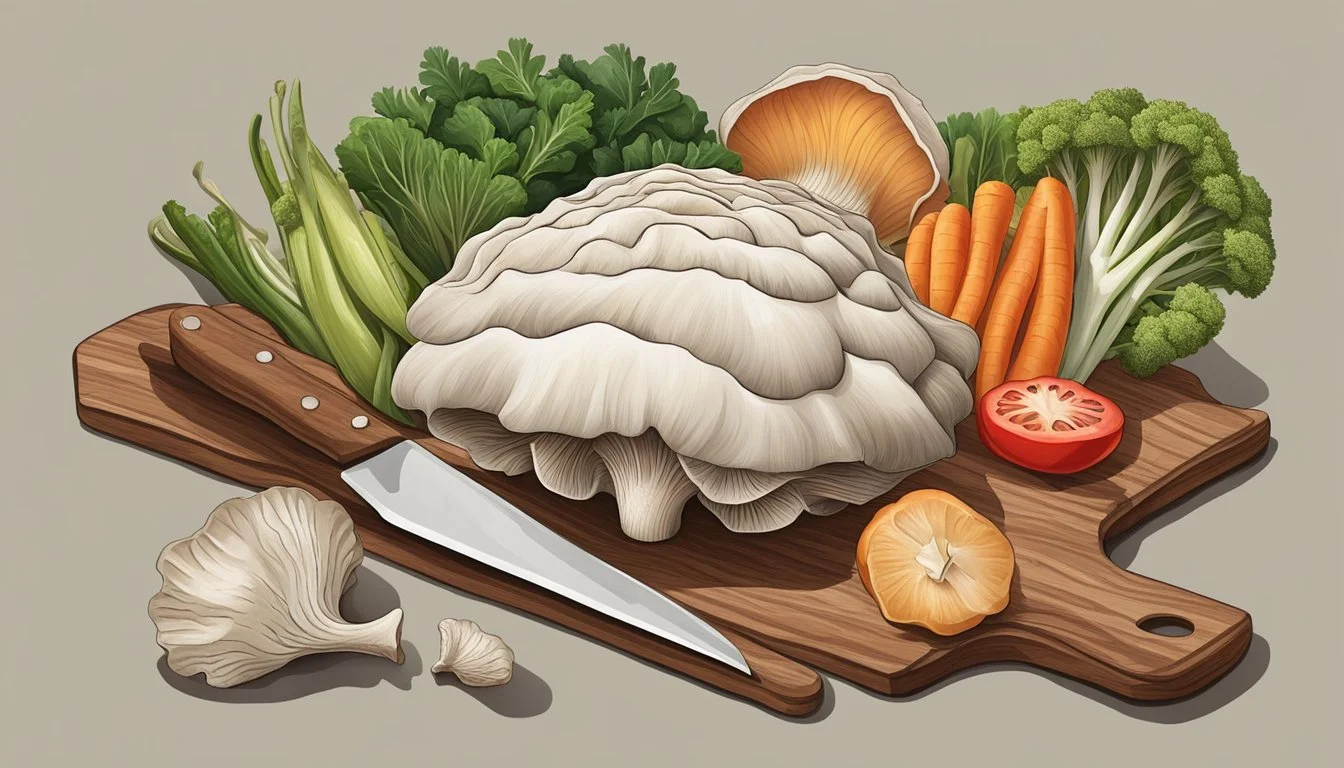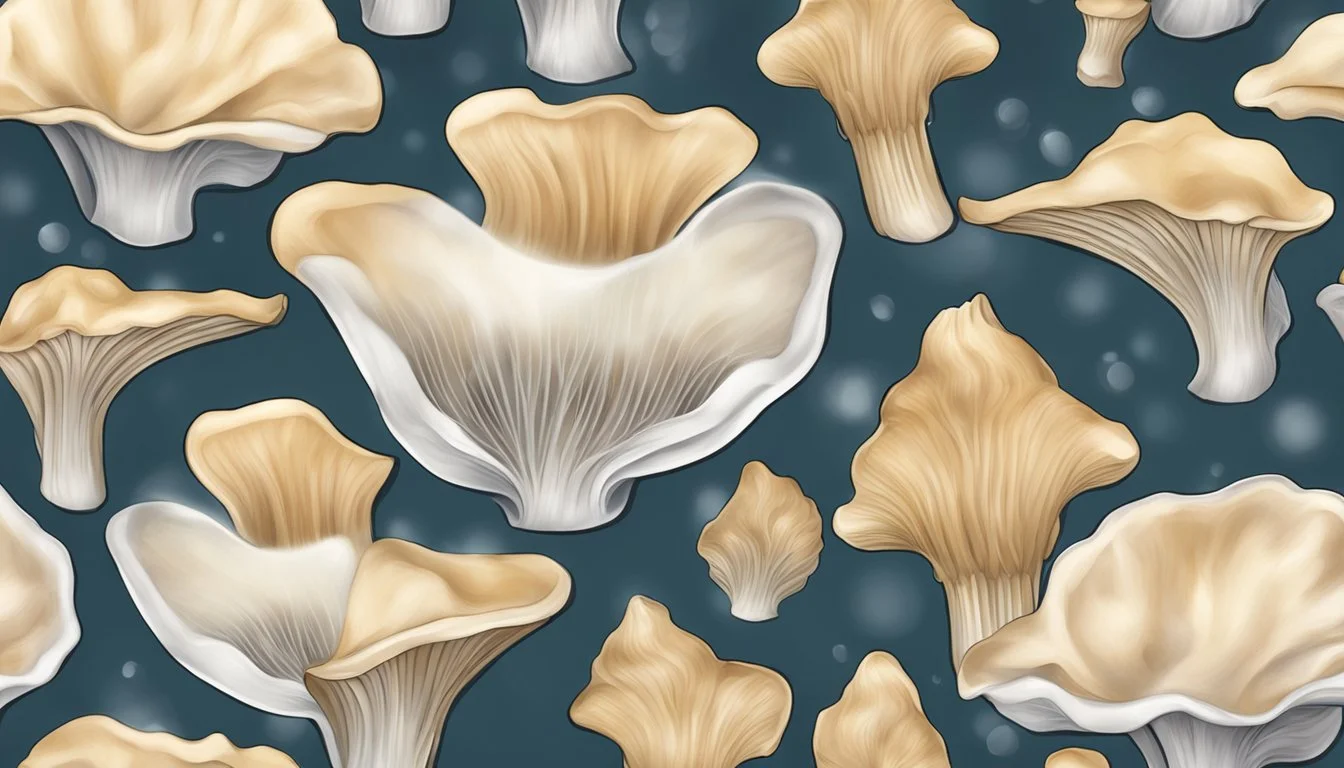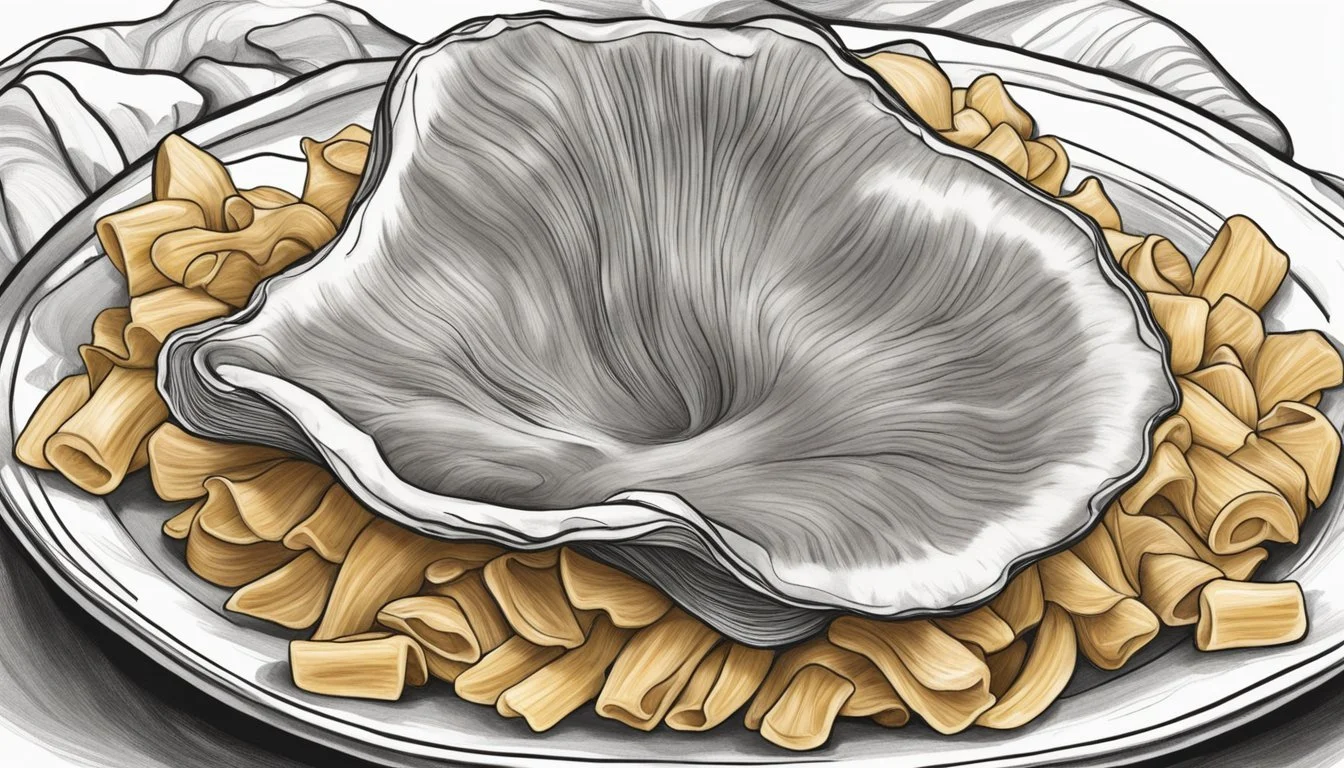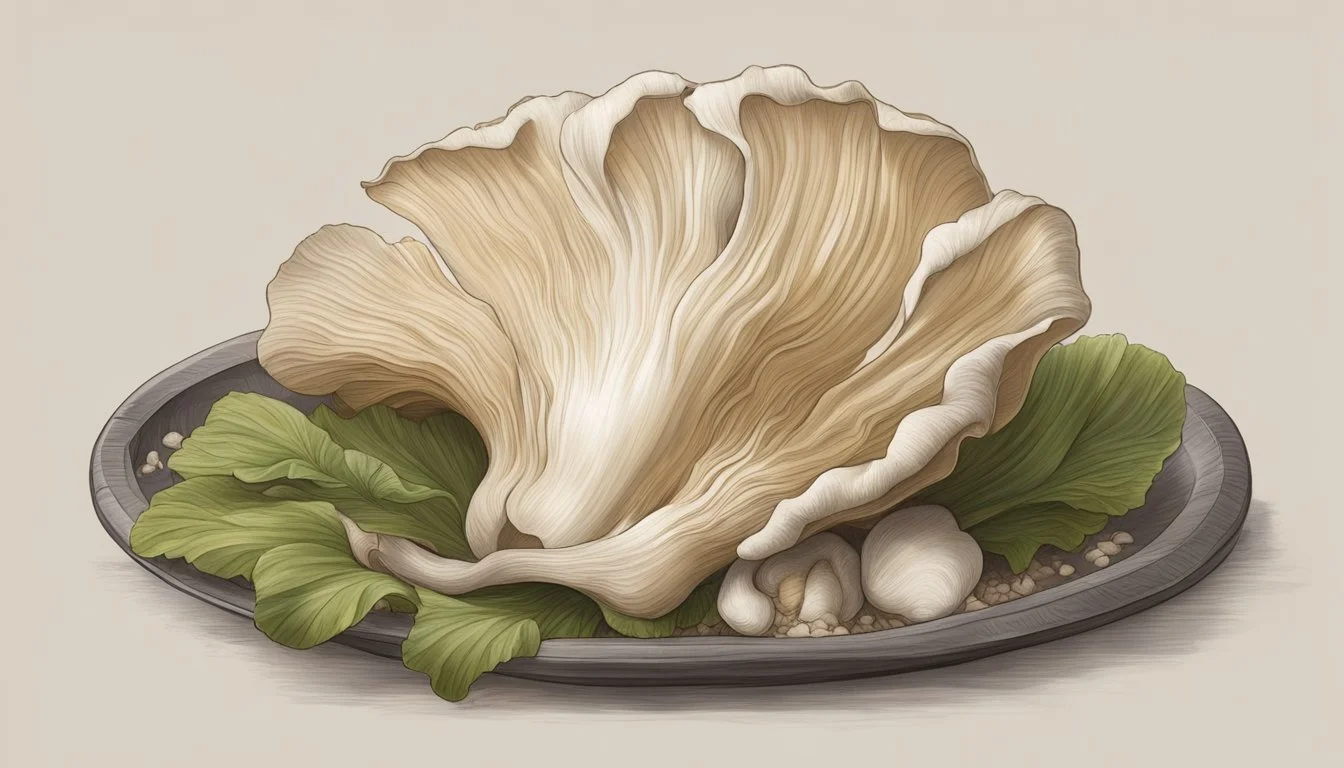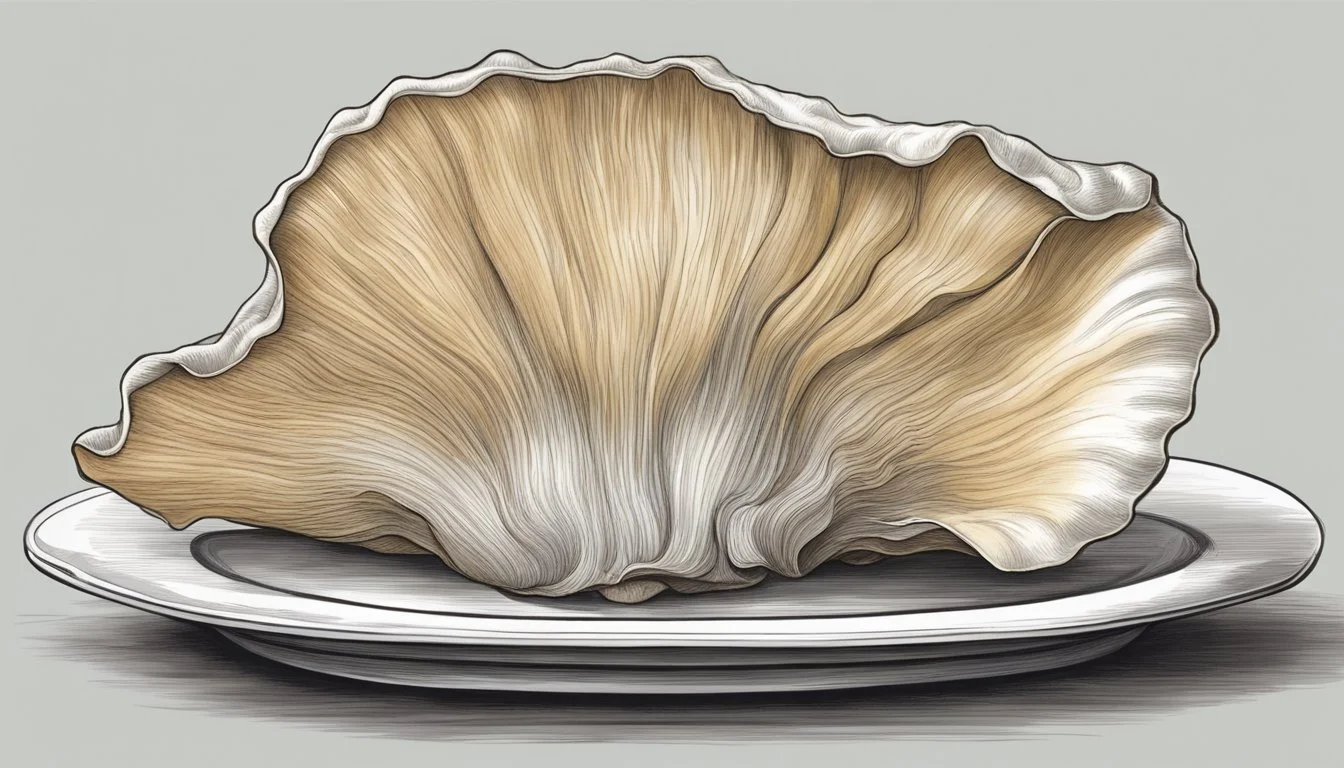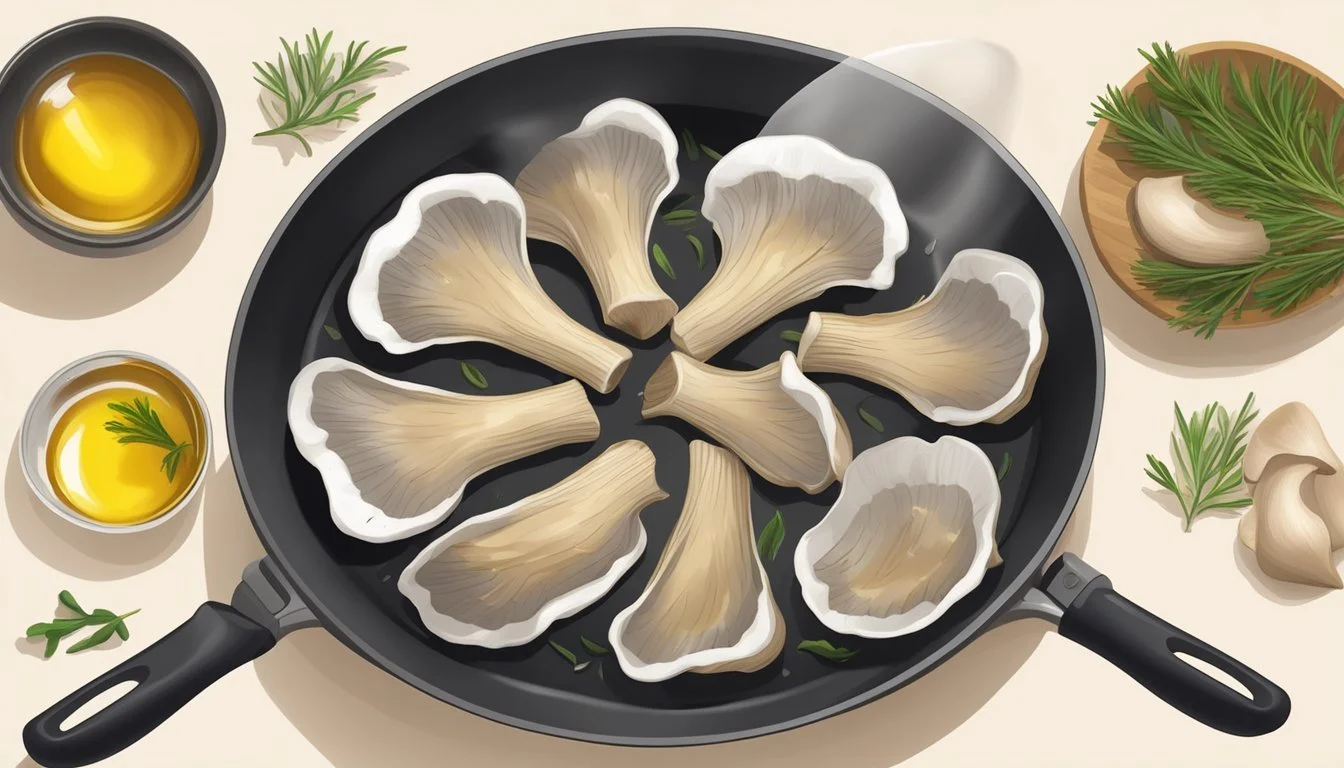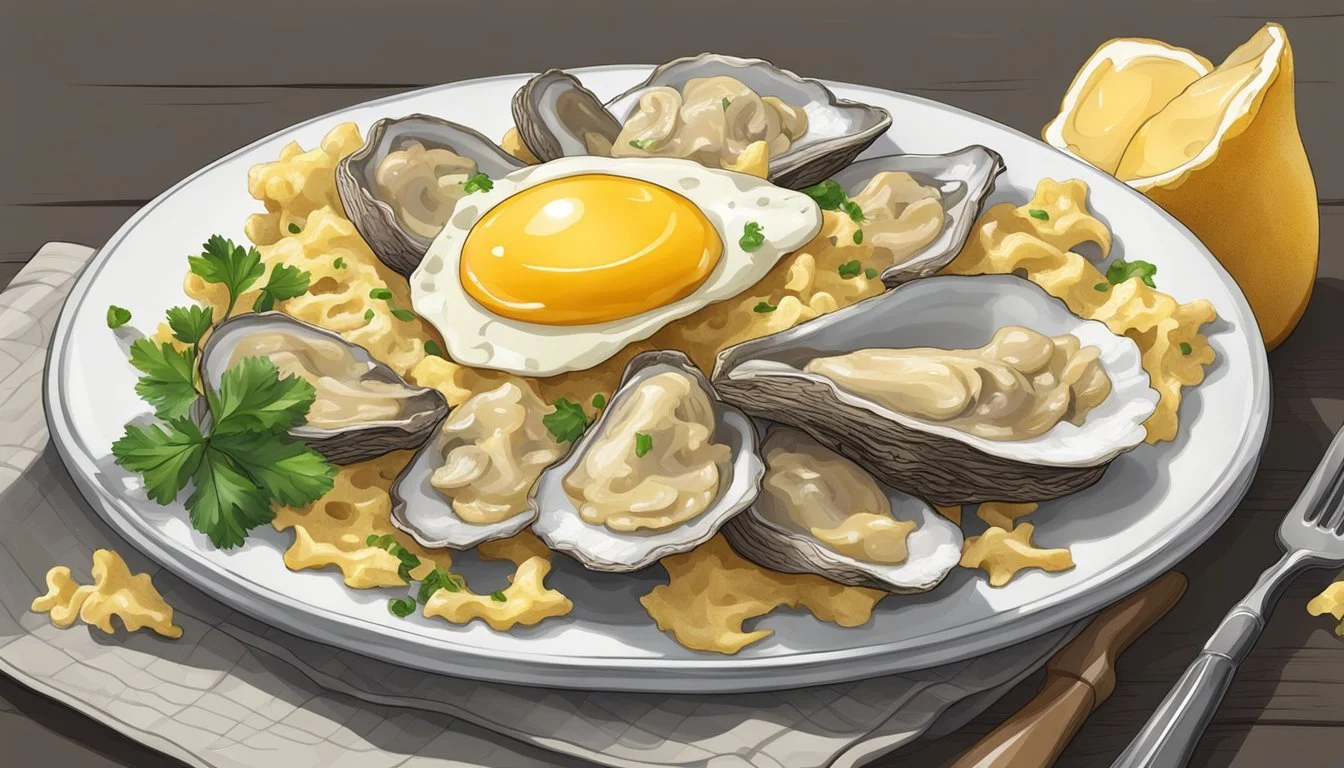How to Eat an Oyster Mushroom:
Simple Prep and Serving Tips
Oyster mushrooms (What wine goes well with mushrooms?), with their subtle flavor and velvety texture, have garnered attention as a versatile ingredient in the culinary world. They can be sautéed, grilled, stir-fried, or even enjoyed raw in salads. On top of their culinary appeal, these mushrooms offer a range of health benefits. They are low in calories yet rich in proteins, vitamins, minerals, and antioxidants. The inclusion of oyster mushrooms in a diet can contribute to improved heart health and immune function.
Preparing oyster mushrooms for consumption is a straightforward process that enhances their delicate taste. A gentle cleaning to remove any debris is usually sufficient since they grow on trees and do not absorb much soil. The stems of oyster mushrooms are typically tougher than the caps, so they can be trimmed. The caps themselves can be left whole or sliced, depending on the recipe's requirements. Once prepped, oyster mushrooms can be cooked quickly over medium-high heat until they are tender and slightly browned.
Incorporating oyster mushrooms into meals not only enriches the flavor profile but also boosts the nutritional content of the dish. Their versatility allows them to be a healthy addition to a wide array of recipes, making them a favorite among home cooks and professional chefs alike. Whether included in a savory stir-fry, creamy pasta, or as a meat substitute in vegetarian dishes, oyster mushrooms adapt well, absorbing flavors while contributing their own subtle, earthy nuance.
Identification of Oyster Mushrooms
Proper identification of oyster mushrooms is crucial before consumption. This section guides the reader through the distinguishing characteristics and various types of oyster mushrooms.
Recognizing Characteristics
Oyster mushrooms (Pleurotus spp.), named for their oyster-shaped caps, exhibit a few recognizable features. Decurrent gills are a hallmark: the gills run down the stem and are attached to it. These mushrooms often grow in shelf-like clusters on dead or dying trees. The cap is typically broad and fleshy, with a size that can vary significantly. As the mushroom matures, the edges of the cap flatten out from an initially enrolled form. The color palette of oyster mushrooms usually spans shades of tan to brown, though this may vary among species.
Different Types of Oyster Mushrooms
While there are various species within the oyster mushroom category, two stand out for their popularity and culinary use:
King oyster mushrooms (Pleurotus eryngii): This type is recognizable by its thick, white stalk and smaller tan cap. They are meatier with a more robust flavor compared to other oyster mushrooms.
Pearl oyster mushrooms (Pleurotus ostreatus): These have a more traditional oyster mushroom appearance with a paler coloration, ranging from white to light brown, and a less dense texture.
These distinct types often vary in texture, taste, and colors, marking their significance in the culinary world. Understanding these differences is key to correctly identifying oyster mushrooms.
Nutritional Profile
Oyster mushrooms are celebrated for their rich nutritional profile, which includes a balance of essential macronutrients and an array of vitamins and minerals. These components contribute to the overall health benefits associated with the consumption of oyster mushrooms.
Macronutrients and Calories
Oyster mushrooms are a low-calorie food with a substantial amount of protein and a low fat content. A 100-gram serving typically contains:
Calories: 33
Protein: 3 grams
Fat: 0.4 grams
Carbohydrates: 6 grams
Fiber: 2 grams
This combination of high protein and fiber with low fat makes them an excellent choice for those looking to maintain or lose weight while still getting essential nutrients.
Vitamins and Minerals
These mushrooms are an excellent source of several B vitamins, particularly niacin and riboflavin, which are key for energy production and overall cellular health. They also provide a significant amount of pantothenic acid and moderate levels of folate. Oyster mushrooms contain a fair amount of minerals such as potassium, iron, and phosphorus. Here's an overview:
Niacin: Essential for the body's energy metabolism
Riboflavin: Supports cellular energy production
Potassium: Important for muscle and nerve function
Iron: Crucial for blood health
Phosphorus: Vital for teeth and bone health
Health-Promoting Compounds
In addition to vitamins and minerals, oyster mushrooms are noted for their antioxidants and beta-glucans. These substances are significant due to their roles in supporting the immune system and potentially reducing cholesterol levels. Beta-glucans are a particular type of fiber that has been researched for its effects on cholesterol and immune response. Antioxidants present in these fungi help combat oxidative stress, which is linked to various chronic diseases.
Preparation Techniques
Before cooking oyster mushrooms, it's crucial to prepare them correctly. Proper cleaning ensures the removal of any dirt, while cutting and trimming allow for desirable texture and consistency in dishes.
Cleaning Oyster Mushrooms
Oyster mushrooms must be clean before they are cooked. Since these fungi can accumulate dirt, chefs often recommend a gentle yet thorough cleaning. One should never soak mushrooms as they absorb water, becoming too wet and affecting their texture adversely. Instead, they can be given a quick rinse and immediately patted dry. Alternatively, using a soft brush or paper towel to wipe off any dirt maintains their freshness without them becoming waterlogged.
Cutting and Trimming
The stems of oyster mushrooms are typically tougher than the caps, which is why they are often trimmed. Cutting should be done based on the recipe requirements; large caps can be sliced lengthwise to create even pieces that cook uniformly. Trimming usually involves removing the very end of the stem, which can sometimes be gritty. When trimming, one should cut just enough to eliminate any tough or dirty parts, ensuring the mushrooms are ready for a variety of cooking methods.
Cooking Methods
Oyster mushrooms are a versatile ingredient that can bring a meaty texture and earthy flavor to a meal when prepared correctly. The mushrooms can be cooked using various techniques to create different textures and nuances in flavor. Here is how one can cook oyster mushrooms using three popular methods.
Sautéing Oyster Mushrooms
To sauté oyster mushrooms, one begins by heating about 2 tablespoons of olive oil or butter in a skillet over medium-high heat. The mushrooms should be added to the hot pan in a single layer to ensure even cooking. They should be cooked for approximately 6 minutes, tossed occasionally, until they turn golden brown and crispy on the edges. Adding minced garlic during the last minute of cooking can infuse the mushrooms with a delightful aroma.
Roasting Oyster Mushrooms
For roasting, the oven should be preheated to 400°F (200°C). The cleaned oyster mushrooms can be tossed with olive oil, salt, and any additional seasonings of choice. They should be spread out on a baking sheet in a single layer to ensure they roast evenly. The mushrooms are typically roasted for 20-25 minutes, or until they are tender and have a concentrated flavor.
Grilling Oyster Mushrooms
Grilling requires preheating the grill to a medium-high temperature. Oyster mushrooms can be threaded onto skewers or placed directly on the grill grates after being coated lightly in olive oil. It’s necessary to grill them for about 5-7 minutes on each side. They should be turned once during cooking, until they have grill marks and a slightly charred exterior. This method imparts a smoky flavor to the mushrooms, making them a great addition to barbecues.
Each of these cooking methods offers a unique way to enjoy oyster mushrooms, whether one prefers them pan-fried to a golden hue, roasted to concentration, or infused with a smoky essence from the grill.
Incorporating into Recipes
Oyster mushrooms offer a meaty texture and umami flavor, making them ideal for a variety of recipes. Whether featured as the star of the dish or as an accompaniment, their versatility is unmatched.
Oyster Mushroom as Main Ingredient
When oyster mushrooms take center stage, they can be transformed into the focal point of a dish due to their substantial texture. Sautéing is a popular method; one simply heats the mushrooms in a pan with a bit of oil or butter, along with garlic and perhaps a splash of white wine, until they are golden and tender. Pasta dishes also benefit from the addition of oyster mushrooms, lending a savory note that complements creamy or tomato-based sauces. (What wine goes well with tomato-based sauces?) They can be grilled as well, seasoned with herbs and served atop a bed of greens for a hearty salad, or as a burger substitute, showcasing their robustness.
Oyster Mushroom as Side
As a side dish, oyster mushrooms are equally impressive. They can be baked or roasted with a drizzle of olive oil and a pinch of salt and pepper, which enhances their natural flavors. Stir-frying with vegetables like bok choy or bell peppers in a light sauce makes for a flavorful and healthy option. Additionally, they are an excellent topping for meat dishes, where their savory quality complements proteins such as steak or chicken, without overpowering them.
How to Eat Oyster Mushrooms
Oyster mushrooms are versatile in preparation and can be cooked using a variety of methods that highlight their unique flavor and texture. Here are some common ways to enjoy them:
Sautéing: They can be quickly sautéed in olive oil with garlic until they're lightly browned and tender, which usually takes between 8 to 10 minutes on medium-high heat. Finish with a sprinkle of salt.
Roasting: For a more intense flavor, toss the mushrooms with olive oil, salt, pepper, and preferred herbs, and roast in a preheated oven at 425°F until they are crispy.
Raw: Oyster mushrooms can be eaten raw in salads, although this is less common due to their subtle flavor which is enhanced through cooking.
When incorporating oyster mushrooms into dishes, one may follow these tips for preparation:
Clean them gently with a damp cloth to remove any dirt.
Trim the ends of the stems if they're tough.
Cut or shred the mushrooms into the desired size, keeping in mind they will reduce when cooked.
Nutritionally, oyster mushrooms are a healthy choice. They provide essential nutrients, low in calories, and contain minimal fat. Adding them to one's diet offers a source of protein and a range of vitamins and minerals.
Recipes
Oyster mushrooms are a versatile ingredient that can be incorporated into a variety of dishes. They can be sautéed, grilled, roasted, and even incorporated into soups. Here are a few recipes that highlight the unique flavor and texture of oyster mushrooms:
Sautéed Oyster Mushrooms with Garlic:
Preparation: Heat oil in a pan over medium-high heat.
Cooking: Arrange the mushrooms in a single layer, cook until golden brown on one side, then toss.
Seasoning: Sprinkle with salt and pepper.
Garlic Butter Oyster Mushrooms:
Ingredients: Oyster mushrooms, butter, garlic, soy sauce.
Method: Similar to sautéed mushrooms, but with the addition of soy sauce for an Asian-inspired flavor profile.
Creamy Cajun Oyster Mushroom Pasta:
Features: Quick to prepare, with a blend of spicy and creamy flavors.
Ingredients: Oyster mushrooms, pasta, Cajun seasoning, cream, bell peppers.
For those seeking a meat-free alternative, oyster mushrooms make an excellent substitute due to their hearty texture. Dishes such as tacos and tamales can be enhanced with the addition of these mushrooms for a complex and satisfying flavor.
Lastly, for enthusiasts of Asian cuisine, incorporating oyster mushrooms into a vegan pho broth adds a rich umami taste. Spices, charred vegetables, and miso can be combined to create a soul-satisfying soup that features oyster mushrooms as a key ingredient.
Soups
One can enjoy the delicate flavor and tender texture of oyster mushrooms by incorporating them into soups. These mushrooms make an ideal addition due to their ability to absorb flavors from other ingredients while contributing their own subtle earthiness.
Preparing the Mushrooms:
Clean gently with a brush or a damp paper towel to remove debris.
Trim off any tough or woody parts of the stem.
Cut or tear into desired sizes, maintaining uniformity for even cooking.
Making the Soup:
Start by sautéing aromatic vegetables such as onions, garlic, and celery in olive oil or another fat until translucent.
Add the oyster mushrooms and cook until they are slightly browned to enhance their flavor.
Deglaze the pot with a splash of white wine or stock, scraping up any browned bits for added depth of flavor.
Pour in a quality stock, either vegetable or chicken, depending on dietary preferences.
Include herbs and spices like thyme, bay leaves, or ginger for complexity.
Cooking:
Bring to a boil and then simmer for a minimum of 15 minutes.
For creamier soups, coconut milk or cream can be introduced near the end of cooking.
Adjust seasoning with salt and black pepper to taste.
In certain recipes, other vegetables such as carrots, tomatoes, or leeks may be added, along with items like miso or coconut milk for a unique flavor twist. The key is to simmer the soup gently, allowing the flavors to meld harmoniously and the mushrooms to maintain their texture.
Pasta with Oyster Mushrooms
Oyster mushrooms have a subtle flavor and a tender yet chewy texture, making them an excellent addition to pasta dishes. For a classic preparation, one can simply sauté oyster mushrooms in butter or olive oil with a touch of salt and black pepper, and then toss them with cooked pasta and a sprinkle of fresh parsley for an easy yet flavorful meal.
Creamy sauces (What wine goes well with creamy sauces?) complement the delicate taste of oyster mushrooms. To incorporate them into a creamy pasta, begin by cooking the mushrooms in a skillet until they're lightly browned. A combination of garlic, salt, and pepper can be added for seasoning. The creamy element is usually introduced by adding heavy cream to the cooked mushrooms, letting it simmer to thicken and absorb the flavors. Pasta water may be included to adjust the sauce's consistency. Finally, the cooked pasta is combined with the sauce, ensuring the noodles are evenly coated.
Tomato-based sauces can also benefit from the addition of oyster mushrooms. After sautéing onions and garlic in oil, the oyster mushrooms are introduced to the mix. The addition of wine helps to deglaze the pan and impart a rich flavor. Chopped peeled tomatoes along with herbs and seasonings, such as basil, chili powder, salt, and pepper, are cooked to create a hearty sauce. This is then poured over spaghetti and gently mixed.
For those seeking a vegetarian alternative to traditional meat dishes, oyster mushrooms can be used in a piccata-style pasta. Employing oyster mushrooms in place of chicken, the dish stays true to the caper-infused, zesty piccata sauce, with a medley of mushrooms like cremini and shiitake adding depth to the flavor profile.
PASTA WITH OYSTER MUSHROOMS
Ingredient Preparation Method Note Oyster Mushrooms Sautéed until tender Base for various pasta sauces Creamy Sauce Simmered with cream Use pasta water to thin sauce Tomato Sauce Cooked with herbs & wine Accommodates additional spices Piccata Style Mushrooms as meat substitute Caper-infused sauce
In short, the incorporation of oyster mushrooms into pasta dishes introduces a savory and meaty texture that can be versatile across various sauce bases, from rich and creamy to tangy and tomato-based.
Rice
Incorporating oyster mushrooms into rice dishes elevates the flavor with their delicate, earthy taste. One can sauté the mushrooms before adding them to fried rice, ensuring each grain is coated evenly in the pan for a satisfying texture. For a subtle umami depth, finely chopped oyster mushrooms blend seamlessly into the mix.
For those seeking a hearty meal, a Mushroom Oyster Rice Bowl (Oyster Donburi) is a nourishing choice. The process involves simmering the mushrooms with oysters (What wine goes well with oysters?), then enhancing the dish with a delicately drizzled, beaten egg, cooked until just silky.
Cooking Steps for Fried Rice with Oyster Mushrooms:
Sauté Aromatics: Fry garlic, ginger, diced carrot, and onion in vegetable oil.
Prepare Mushrooms: Chop oyster mushrooms into bite-sized pieces.
Cook Rice: Add day-old, cooked rice to the pan, frying it with the aromatics.
Seasoning: Incorporate soy sauce or other seasonings to taste.
Combine: Mix in oyster mushrooms and cook until tender.
Garnish: Finish with chopped scallions for a fresh pop of color and flavor.
A well-prepared dish of oyster mushroom fried rice is both comforting and satisfying, showcasing the mushrooms’ versatility. It serves as a wholesome meal on its own or as a complementary side to other dishes.
Side Dish
When considering oyster mushrooms as a side dish, they are a versatile and flavorful option. They possess a meaty texture that can mimic more traditional meat-based sides, making them popular among vegetarians and meat-eaters alike.
Ingredients:
Oyster mushrooms
Salt
Pepper
Garlic
Cooking oil (or butter)
Additional herbs (such as thyme or shallot) (optional)
Method:
Begin by cleaning the oyster mushrooms and tearing them into bite-size pieces, disregarding the tough parts of the stems.
Heat oil or butter in a skillet over medium-high heat until hot but not smoking.
Add minced garlic and, if desired, finely chopped additional herbs like thyme or shallot. Sauté for about 1 minute.
Place the mushrooms in a single layer in the pan, allowing them to brown and become crisp on one side before stirring.
Cook for a total of 7 to 10 minutes, until mushrooms are browned and any released moisture has evaporated.
Season with salt and pepper to taste.
The mushrooms should reduce in volume as they cook. The key to achieving a satisfying texture and depth of flavor is to let them brown properly, which means not overcrowding the pan and refraining from stirring too often.
Depending on individual taste preferences, oyster mushrooms can be enhanced with sauces such as oyster sauce or soy sauce for an Asian twist. Serving these mushrooms alongside a variety of dishes such as grilled meats, seafood, or even incorporated into pasta, enriches the meal with a hearty and earthy component.
Soup
When incorporating oyster mushrooms into soup, one starts by preparing the mushrooms. They should be cleaned and sliced to a suitable size. Oyster mushrooms provide a delicate texture and can easily absorb flavors from other ingredients, making them an ideal choice for soups.
Basic Steps:
Sautéing: Begin by heating olive oil in a large pot. Add aromatic ingredients such as onions, garlic, leeks, or celery, sautéing until softened.
Incorporating Mushrooms: Introduce the oyster mushrooms to the mix, allowing them to cook until they are tender and have released their moisture.
Building Flavor: Incorporate spices such as thyme or bay leaves for a herby note. Aromatic vegetables like carrots can be added in this phase.
Thickening (Optional): Some recipes might call for a thickener like flour; if used, it's typically stirred in with the vegetables and cooked before adding liquids.
Liquid Addition: Pour in vegetable or mushroom broth as the base and bring the soup to a boil. Lower the heat and allow it to simmer.
Common Flavor Pairings:
Garlic & Onions: They form a flavor foundation for most soups.
Carrots & Potatoes: They contribute a natural sweetness and heartiness.
Thyme & Bay Leaves: Herbs add depth to the broth.
Miso & Ginger: Used in some recipes for a flavorful twist.
To achieve a creamy texture, some may introduce coconut milk, dairy cream, or plant-based alternatives at the final stage of cooking. This should simmer briefly to integrate without curdling. Oyster mushroom soup is both versatile and forgiving, allowing for variations based on personal taste and dietary preferences.
Mushroom Recipes
Oyster mushrooms are versatile and can be prepared in various delicious ways, lending their meaty texture to a myriad of dishes. One can simply sauté them, with an easy recipe involving a nonstick pan heated over medium-high heat, a touch of olive oil, and the mushrooms cooked until one side is golden brown. It is recommended to season them with salt and pepper.
Garlic Butter Oyster Mushrooms make for a richly flavored dish, enhanced with a dash of soy sauce for an Asian-inspired taste. It is suggested that one adds garlic to enrich the mushrooms' flavor profile.
To diversify the usage of oyster mushrooms, consider incorporating them into pastas, tacos, or tamales. They can complement appetizers or side dishes and pair well with seafood, offering a substantial texture.
For those seeking a quick sauté, cooking the mushrooms with herbs can be satisfying. One can stir them in oil, add a finely chopped shallot, some butter, and preferred herbs, cooking until the mushrooms are browned and have reduced in volume.
Below is a streamlined cooking method to start with:
Ingredients:
Oyster mushrooms
Olive oil
Salt and pepper
Garlic (optional)
Soy sauce (for an Asian twist)
Instructions:
Heat oil in a pan over medium-high.
Add mushrooms in one layer, cook until golden.
Season with salt, pepper, and optionally, garlic.
For a richer flavor, introduce soy sauce near the end.
These methods provide the foundation for endless creativity with oyster mushrooms in the kitchen.
Oyster Mushroom Recipes
Oyster mushrooms are versatile in the kitchen and can be the star in a variety of dishes. One can prepare them by sautéing, which brings out their natural flavor. For a simple dish, heat olive oil in a pan, add the mushrooms, and then season with salt and pepper, sautéing until golden brown.
For those who enjoy bolder flavors, garlic butter oyster mushrooms are an excellent choice. In a pan, mushrooms are cooked until crispy and then tossed with a mixture of butter, garlic, and soy sauce. This adds a savory depth that complements the delicate texture of the mushrooms.
Here's a quick view of how one might cook oyster mushrooms:
Sautéed Oyster Mushrooms
Heat oil over medium-high heat.
Add oyster mushrooms to the pan.
Season with salt and pepper.
Sauté until golden, about 6-8 minutes.
Garlic Butter Oyster Mushrooms
Begin as you would for sautéed mushrooms.
Add a blend of melted butter, minced garlic, and a splash of soy sauce.
Continue to cook until the mushrooms have absorbed the flavors.
Oyster mushrooms can also elevate classic dishes such as pasta, tacos, and side dishes. When added to pasta, they bring a meaty texture and can be mixed with cream or tomato-based sauces. In tacos or tamales, they act as a hearty filling. As a side, they pair well with both meat and seafood, making them an ideal candidate for a well-rounded plate.
Cuisine
Oyster mushrooms are a sublime ingredient in the culinary world renowned for their delicate texture and subtle flavor, which bears a hint of anise. They are highly adaptable and can be incorporated in various cuisine styles, from simple sautés to complex dishes.
Preparation Techniques:
Sautéeing: They can be sautéed with garlic for a simple yet flavorful dish. A golden brown sear is desirable for a mix of texture and taste.
Grilling: Oyster mushrooms hold up well to grilling, often used in salads for a smoky flavor.
Common Pairings and Ingredients:
Seasonings: Salt, pepper, and aromatic herbs like thyme or oregano.
Fats: Cooking mediums include olive oil or butter to enhance their natural flavors.
Others: Often combined with onions and garlic, these mushrooms can also be enriched with cream for a decadent sauce.
Diverse Dishes:
Appetizers: They work splendidly in broths or as a topping on bruschetta.
Main Courses: Oyster mushrooms are hearty enough for main dishes, complementing pasta, risottos, and as a meat substitute in tacos.
Side Dishes: They mingle well with other vegetables for a savory side course.
The versatility of oyster mushrooms transcends culinary borders, making them an excellent choice for chefs and home cooks alike to explore and enjoy in myriad gastronomic creations.
Cooking with Oyster Mushrooms
Oyster mushrooms are known for their delicate texture and slightly sweet, anise-like flavor, making them a favorite in culinary circles. When cooking with oyster mushrooms, it's essential to start with proper preparation. They should first be cleaned gently with a damp cloth and then have their tough base trimmed.
Sautéing is a popular method to cook oyster mushrooms. A simple yet effective approach involves:
Heating 2 tablespoons of olive oil in a large pan over medium-high heat.
Adding the mushrooms once the oil is shimmering.
Seasoning with salt and pepper.
Cooking without stirring for a few minutes, allowing one side to turn golden brown, then tossing to cook the other side evenly for about 6 minutes total.
They also lend themselves well to a variety of other cooking methods, including:
Stir-frying: Combine with vegetables for a quick, flavorful dish.
Roasting: Gives them a crispy texture, ideal for adding to salads or as a topping on pizzas.
Grilling: Enhance their flavor with a smoky char.
Cooking Methods
Method Description Cooking Time Sauté Cook quickly in hot oil until golden brown 6 minutes Stir-fry Cook rapidly on high heat with vegetables and sauces 5-7 minutes Roast Cook in the oven until edges are crisp 20-25 minutes Grill Char over open flame or on a grill pan 3-5 minutes per side
For those who enjoy experimenting, these mushrooms are a versatile ingredient. They can be incorporated into soups, used as a meat substitute in vegetarian dishes, or simply served on toast for a satisfying appetizer. When cooked properly, oyster mushrooms can elevate any dish with their unique flavor and pleasingly chewy texture.
Stir-Fries
Incorporating oyster mushrooms into stir-fries is a straightforward and popular method. As these mushrooms have a subtle woody flavor and firm texture, they hold up well against the high heat required for stir-frying.
Ingredients:
Oyster mushrooms
Cooking oil (vegetable or peanut)
Aromatics (garlic, ginger, shallots)
Additional vegetables (optional)
Soy sauce or other seasonings
Instructions:
Preparation: Begin by cleaning the oyster mushrooms, carefully removing any dirt. Split large mushrooms into smaller, even pieces for consistent cooking.
Heat Oil: Add a dash of cooking oil to a wok or large skillet over medium-high heat, allowing it to reach a temperature just before smoking.
Cook Aromatics: Once the oil is hot, toss in minced garlic, ginger, or shallots to infuse the oil with flavor. This usually takes about 30 seconds.
Mushrooms: Add the oyster mushrooms to the pan, ensuring they are spaced well. They should be sautéed until they begin to brown lightly, which may take around 6 minutes.
Vegetables and Seasonings: For additional color and nutrition, include other vegetables such as bell peppers or onions. Now is also the time to add seasonings like soy sauce, balancing the umami flavor with the mushrooms.
Stir and Serve: Keep the ingredients moving in the pan to avoid burning. Once the mushrooms have softened and are thoroughly coated with seasonings, remove the stir-fry from heat and serve immediately.
Note: Oyster mushrooms have a high water content; avoid crowding the pan to prevent them from steaming rather than stir-frying. This method ensures a delectable texture and enhanced flavors, making oyster mushroom stir-fries a simple yet impressive dish.
Stir Fry
One of the most popular ways to prepare oyster mushrooms is to stir-fry them. This cooking method is quick and enhances the mushrooms' natural flavors. Stir-frying oyster mushrooms requires simple steps and commonly found ingredients.
First, one should heat a wok or skillet over medium-high heat and add a high smoke point oil, like vegetable or peanut oil. Aromatics such as minced garlic, ginger, or shallots are then added once the oil is hot. These ingredients infuse the oil and, consequently, the mushrooms, with layers of flavor.
When the aromatics are fragrant, after about 30 seconds, the oyster mushrooms should be added to the pan. It's important to stir them well and then let them cook undisturbed for a short period, which allows parts of the mushrooms to brown slightly, adding a depth of flavor. During this step, a pinch of sugar can be sprinkled on top to help with caramelization.
After about 1 to 2 minutes, season the mushrooms with a sprinkle of salt, and then pour soy sauce over them. One must quickly stir the mushrooms to evenly coat them with the soy sauce until it's absorbed, which should take about another minute.
Ingredient Preparation Duration Oyster Mushrooms Cleaned and trimmed Stir-fry 2-3 minutes Oil High smoke point (vegetable or peanut) Heat until shimmering Garlic, Ginger Minced Sauté ~30 seconds Soy Sauce Pour and stir for 1 minute
During stir-frying, additional vegetables or ingredients can be added based on personal taste preferences. One should remember that oyster mushrooms have a subtle flavor, so they shouldn't be overpowered by other strong flavors.
Scrambled Eggs with Oyster Mushrooms
When incorporating oyster mushrooms into scrambled eggs, one enjoys the benefits of a hearty, flavorsome dish with a boost of nutrients. Oyster mushrooms are known for their delicate texture and slightly peppery taste, which can complement the creamy softness of scrambled eggs.
Ingredients:
Oyster mushrooms, cleaned and sliced
Eggs, beaten
Butter
Salt
Pepper
Optional: cream, garlic scapes, chopped chives (how long do chives last?), or onions for added flavor
Method:
In a skillet, melt butter over low heat.
Add the oyster mushrooms and sauté for 2-3 minutes. Season with salt and pepper.
Mix the beaten eggs with a bit of cream if desired, then add to the skillet.
Gently stir the eggs a few times as they cook to achieve a soft, curdled texture. This process should only take a few minutes. Avoid over-stirring to maintain the eggs' fluffiness.
Once the eggs begin to set, add any optional ingredients, such as chives or onions, and cook until they're just incorporated.
Remove from heat immediately after the eggs are cooked to prevent overcooking.
One may serve the scrambled eggs with mushrooms on toast or as a stand-alone dish. It's essential to cook the eggs gently and avoid letting them dry out, ensuring the mushrooms retain their moisture and flavor. For additional taste, one could briefly sauté garlic scapes or onions before adding the mushrooms, lending a subtle aromatic layer to the dish. Simple yet satisfying, this dish marries the earthy tones of oyster mushrooms with the rich simplicity of scrambled eggs.
Teriyaki Oyster Mushroom Steak
One can transform the humble oyster mushroom into a sumptuous Teriyaki Oyster Mushroom Steak by following a few simple steps. The preparation begins with preheating the oven to 375ºF. A chef will then trim the bottom root of the mushrooms, ensuring they stay intact for better presentation and even cooking.
In a small bowl, one should mix the teriyaki seasoning, which typically includes soy sauce, sugar, ginger, and garlic, to create the marinade. In a separate bowl, marinating the mushrooms allows them to absorb these rich flavors.
Using a medium bowl for the marinade, the mushrooms should be thoroughly coated and left to sit, which lets the flavor penetrate deeply. Next, a skillet is heated over medium heat with a bit of oil, ideally avocado due to its high smoke point and neutral taste.
The chef places the oyster mushrooms root down in the skillet. They may use a second skillet or a flat weight to press down on the mushrooms to flatten them, which helps in achieving a steak-like texture. The mushrooms should be cooked for around 8-10 minutes to ensure they don't burn and flattened evenly.
Once the mushrooms have achieved a golden brown on both sides, they are transferred to the oven for a final bake, ensuring a thorough cook and an enhanced flavor profile. The final result is a delicious, plant-based steak with layers of complex, savory teriyaki flavor and an appealing texture that mimics traditional steak.
Teriyaki King Oyster Mushroom
Teriyaki King Oyster Mushrooms offer a succulent, meaty texture, making them an ideal choice for plant-based versions of classic teriyaki dishes. To begin preparing this dish, one must first clean the mushrooms by wiping them with a damp cloth.
Preparation Steps:
Slice the mushrooms lengthwise into approximately 4mm thick pieces, which ensures they cook evenly and absorb the marinade well.
Create the teriyaki marinade by combining light soy sauce or tamari, Japanese sake, and sugar in a bowl. Stir until the sugar dissolves completely.
Marinate the mushrooms by soaking them with the sauce, ensuring each slice is well-coated. Some prefer marinating for as little as 15 minutes, while others suggest up to 20 minutes for deeper flavor infusion.
Cooking Process:
Heat a large skillet, preferably cast iron, over medium-high heat. Add a small amount of oil to prevent sticking.
Cook the marinated mushrooms in batches, placing them face down to sear until golden brown. It's noteworthy that the mushrooms may release moisture and sputter.
Tips for a Perfect Dish:
Scoring the mushrooms is an optional step some cooks take, making small cuts on their surface to increase surface area for the marinade.
Garnishing with sesame seeds or green onions after cooking can add both visual appeal and a flavor boost.
Through these methods, teriyaki king oyster mushrooms can easily become a flavorful highlight in a meal.


